Leadership, management, and team working in professional practice
VerifiedAdded on 2023/04/12
|11
|3210
|433
AI Summary
This essay discusses the importance of leadership, management, and team working in professional practice, specifically in the healthcare sector. It explores the qualities and impact of a leader, the influence of communication, change, and conflict on decision-making, and the role of a manager in meeting health service expectations. The essay also highlights the need for a supportive and educative workplace culture and the use of confidentiality in healthcare.
Contribute Materials
Your contribution can guide someone’s learning journey. Share your
documents today.
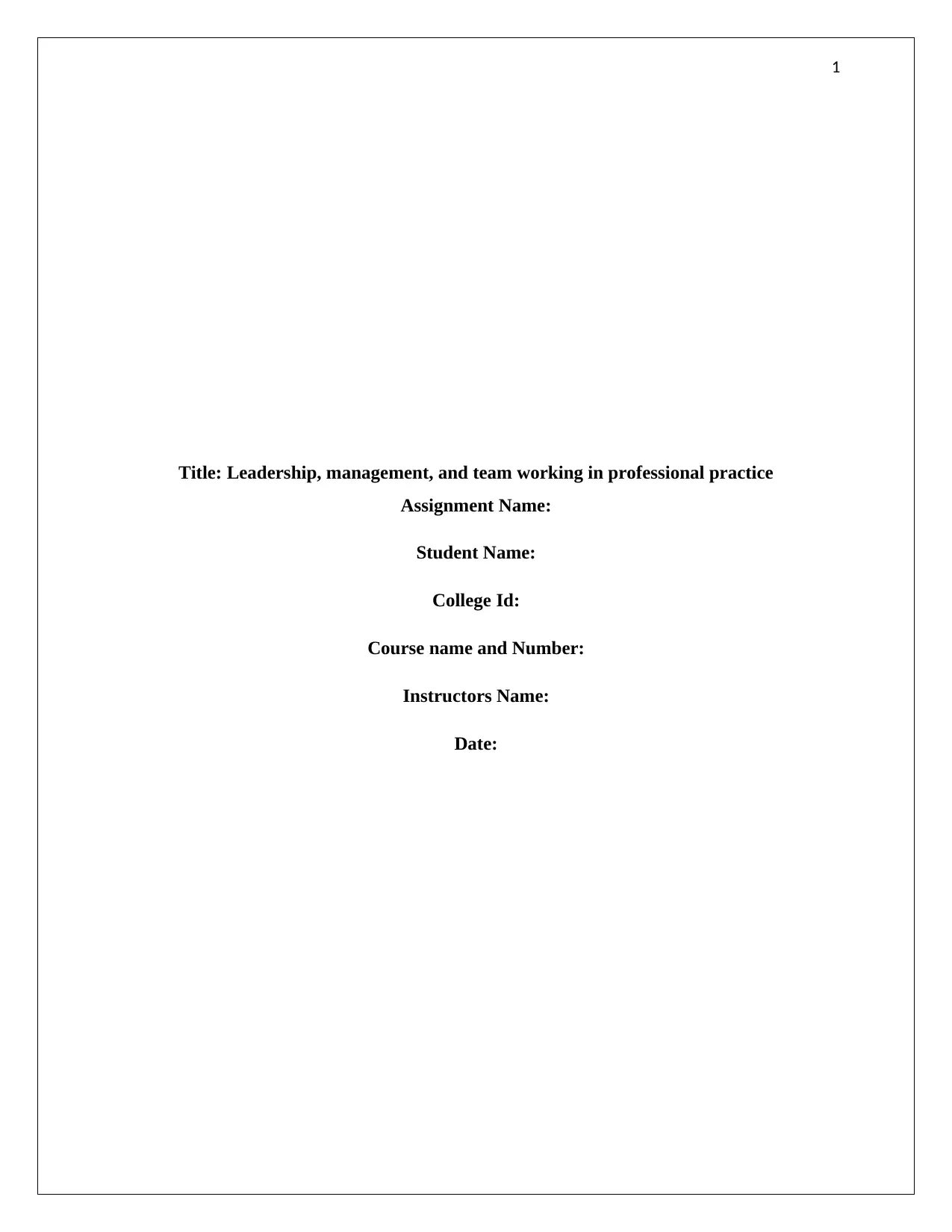
1
Title: Leadership, management, and team working in professional practice
Assignment Name:
Student Name:
College Id:
Course name and Number:
Instructors Name:
Date:
Title: Leadership, management, and team working in professional practice
Assignment Name:
Student Name:
College Id:
Course name and Number:
Instructors Name:
Date:
Secure Best Marks with AI Grader
Need help grading? Try our AI Grader for instant feedback on your assignments.
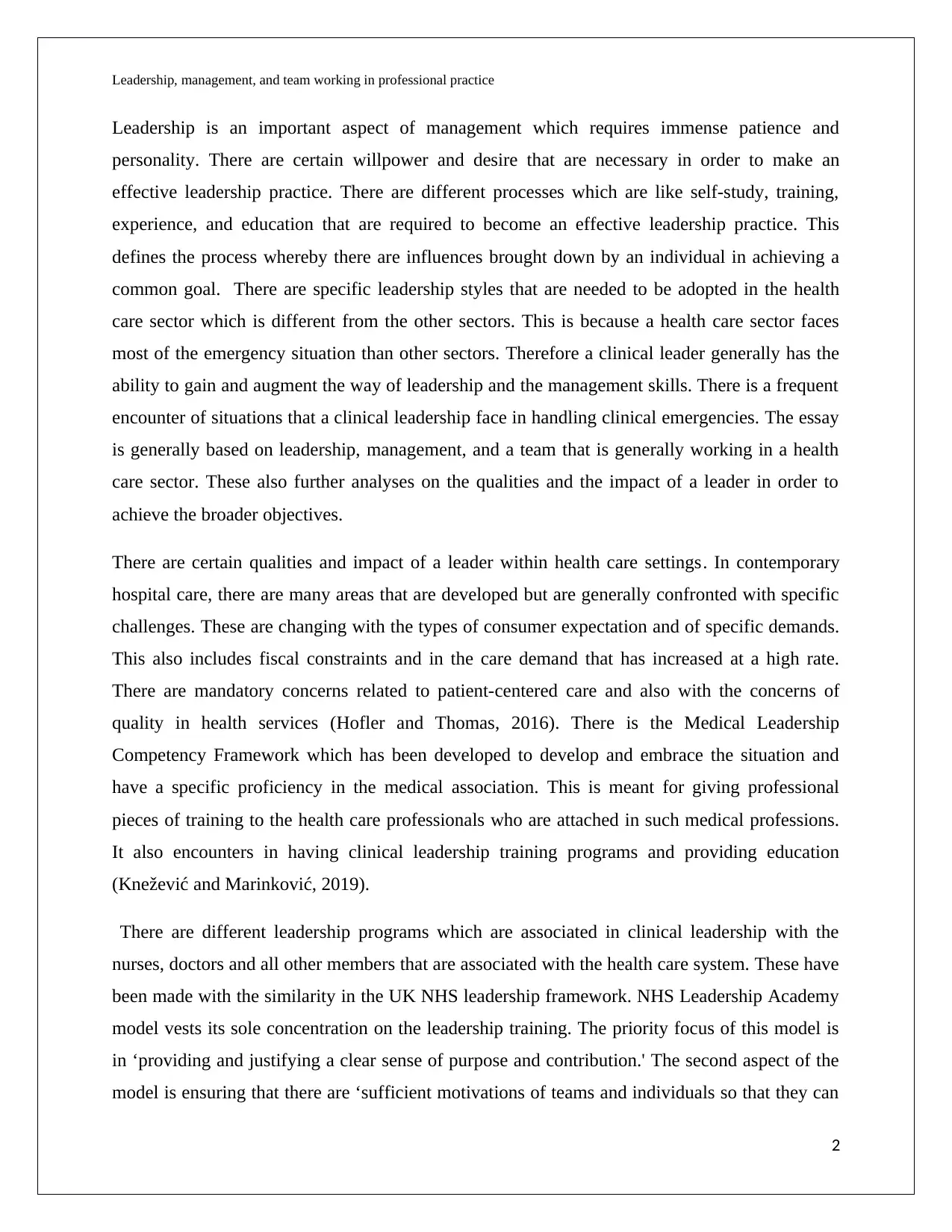
Leadership, management, and team working in professional practice
Leadership is an important aspect of management which requires immense patience and
personality. There are certain willpower and desire that are necessary in order to make an
effective leadership practice. There are different processes which are like self-study, training,
experience, and education that are required to become an effective leadership practice. This
defines the process whereby there are influences brought down by an individual in achieving a
common goal. There are specific leadership styles that are needed to be adopted in the health
care sector which is different from the other sectors. This is because a health care sector faces
most of the emergency situation than other sectors. Therefore a clinical leader generally has the
ability to gain and augment the way of leadership and the management skills. There is a frequent
encounter of situations that a clinical leadership face in handling clinical emergencies. The essay
is generally based on leadership, management, and a team that is generally working in a health
care sector. These also further analyses on the qualities and the impact of a leader in order to
achieve the broader objectives.
There are certain qualities and impact of a leader within health care settings. In contemporary
hospital care, there are many areas that are developed but are generally confronted with specific
challenges. These are changing with the types of consumer expectation and of specific demands.
This also includes fiscal constraints and in the care demand that has increased at a high rate.
There are mandatory concerns related to patient-centered care and also with the concerns of
quality in health services (Hofler and Thomas, 2016). There is the Medical Leadership
Competency Framework which has been developed to develop and embrace the situation and
have a specific proficiency in the medical association. This is meant for giving professional
pieces of training to the health care professionals who are attached in such medical professions.
It also encounters in having clinical leadership training programs and providing education
(Knežević and Marinković, 2019).
There are different leadership programs which are associated in clinical leadership with the
nurses, doctors and all other members that are associated with the health care system. These have
been made with the similarity in the UK NHS leadership framework. NHS Leadership Academy
model vests its sole concentration on the leadership training. The priority focus of this model is
in ‘providing and justifying a clear sense of purpose and contribution.' The second aspect of the
model is ensuring that there are ‘sufficient motivations of teams and individuals so that they can
2
Leadership is an important aspect of management which requires immense patience and
personality. There are certain willpower and desire that are necessary in order to make an
effective leadership practice. There are different processes which are like self-study, training,
experience, and education that are required to become an effective leadership practice. This
defines the process whereby there are influences brought down by an individual in achieving a
common goal. There are specific leadership styles that are needed to be adopted in the health
care sector which is different from the other sectors. This is because a health care sector faces
most of the emergency situation than other sectors. Therefore a clinical leader generally has the
ability to gain and augment the way of leadership and the management skills. There is a frequent
encounter of situations that a clinical leadership face in handling clinical emergencies. The essay
is generally based on leadership, management, and a team that is generally working in a health
care sector. These also further analyses on the qualities and the impact of a leader in order to
achieve the broader objectives.
There are certain qualities and impact of a leader within health care settings. In contemporary
hospital care, there are many areas that are developed but are generally confronted with specific
challenges. These are changing with the types of consumer expectation and of specific demands.
This also includes fiscal constraints and in the care demand that has increased at a high rate.
There are mandatory concerns related to patient-centered care and also with the concerns of
quality in health services (Hofler and Thomas, 2016). There is the Medical Leadership
Competency Framework which has been developed to develop and embrace the situation and
have a specific proficiency in the medical association. This is meant for giving professional
pieces of training to the health care professionals who are attached in such medical professions.
It also encounters in having clinical leadership training programs and providing education
(Knežević and Marinković, 2019).
There are different leadership programs which are associated in clinical leadership with the
nurses, doctors and all other members that are associated with the health care system. These have
been made with the similarity in the UK NHS leadership framework. NHS Leadership Academy
model vests its sole concentration on the leadership training. The priority focus of this model is
in ‘providing and justifying a clear sense of purpose and contribution.' The second aspect of the
model is ensuring that there are ‘sufficient motivations of teams and individuals so that they can
2
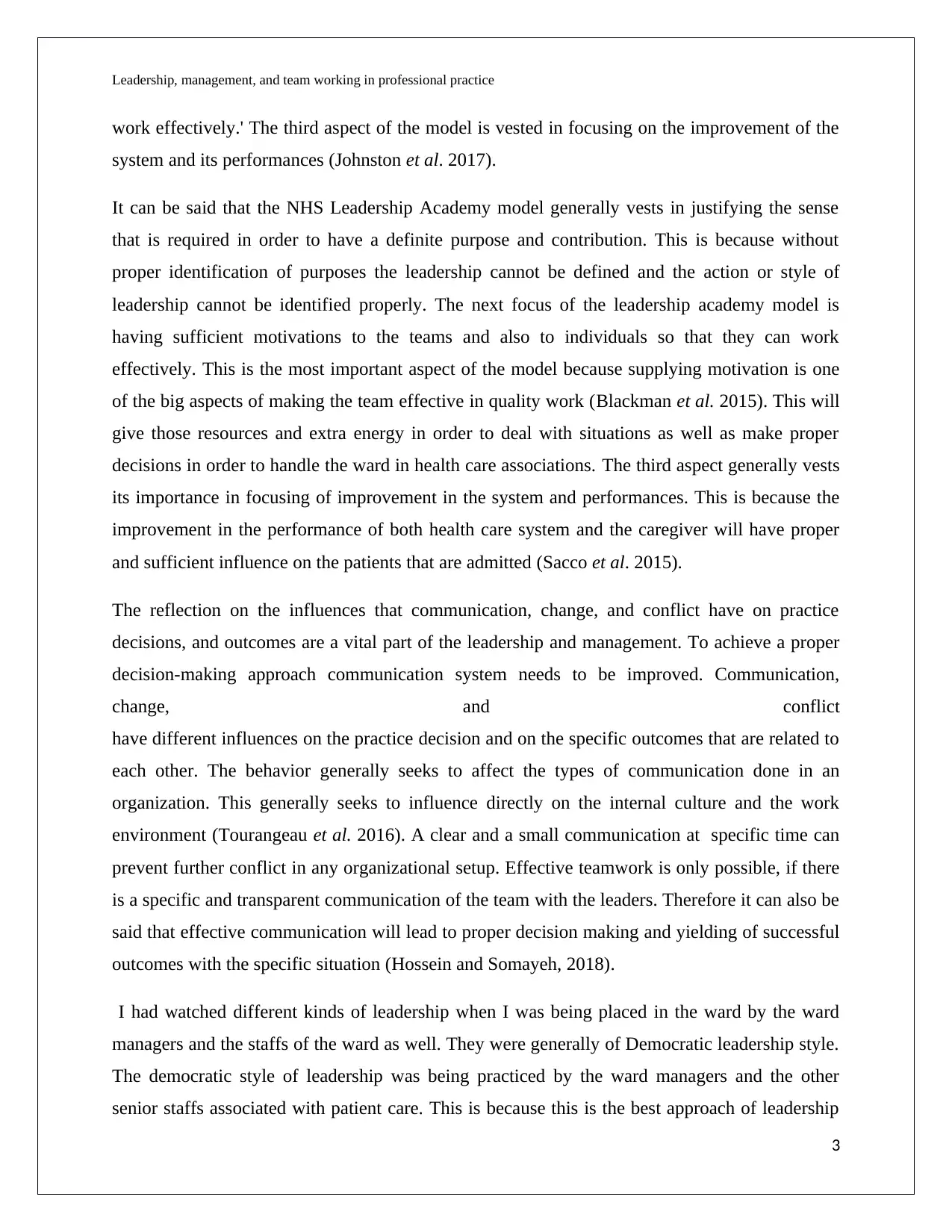
Leadership, management, and team working in professional practice
work effectively.' The third aspect of the model is vested in focusing on the improvement of the
system and its performances (Johnston et al. 2017).
It can be said that the NHS Leadership Academy model generally vests in justifying the sense
that is required in order to have a definite purpose and contribution. This is because without
proper identification of purposes the leadership cannot be defined and the action or style of
leadership cannot be identified properly. The next focus of the leadership academy model is
having sufficient motivations to the teams and also to individuals so that they can work
effectively. This is the most important aspect of the model because supplying motivation is one
of the big aspects of making the team effective in quality work (Blackman et al. 2015). This will
give those resources and extra energy in order to deal with situations as well as make proper
decisions in order to handle the ward in health care associations. The third aspect generally vests
its importance in focusing of improvement in the system and performances. This is because the
improvement in the performance of both health care system and the caregiver will have proper
and sufficient influence on the patients that are admitted (Sacco et al. 2015).
The reflection on the influences that communication, change, and conflict have on practice
decisions, and outcomes are a vital part of the leadership and management. To achieve a proper
decision-making approach communication system needs to be improved. Communication,
change, and conflict
have different influences on the practice decision and on the specific outcomes that are related to
each other. The behavior generally seeks to affect the types of communication done in an
organization. This generally seeks to influence directly on the internal culture and the work
environment (Tourangeau et al. 2016). A clear and a small communication at specific time can
prevent further conflict in any organizational setup. Effective teamwork is only possible, if there
is a specific and transparent communication of the team with the leaders. Therefore it can also be
said that effective communication will lead to proper decision making and yielding of successful
outcomes with the specific situation (Hossein and Somayeh, 2018).
I had watched different kinds of leadership when I was being placed in the ward by the ward
managers and the staffs of the ward as well. They were generally of Democratic leadership style.
The democratic style of leadership was being practiced by the ward managers and the other
senior staffs associated with patient care. This is because this is the best approach of leadership
3
work effectively.' The third aspect of the model is vested in focusing on the improvement of the
system and its performances (Johnston et al. 2017).
It can be said that the NHS Leadership Academy model generally vests in justifying the sense
that is required in order to have a definite purpose and contribution. This is because without
proper identification of purposes the leadership cannot be defined and the action or style of
leadership cannot be identified properly. The next focus of the leadership academy model is
having sufficient motivations to the teams and also to individuals so that they can work
effectively. This is the most important aspect of the model because supplying motivation is one
of the big aspects of making the team effective in quality work (Blackman et al. 2015). This will
give those resources and extra energy in order to deal with situations as well as make proper
decisions in order to handle the ward in health care associations. The third aspect generally vests
its importance in focusing of improvement in the system and performances. This is because the
improvement in the performance of both health care system and the caregiver will have proper
and sufficient influence on the patients that are admitted (Sacco et al. 2015).
The reflection on the influences that communication, change, and conflict have on practice
decisions, and outcomes are a vital part of the leadership and management. To achieve a proper
decision-making approach communication system needs to be improved. Communication,
change, and conflict
have different influences on the practice decision and on the specific outcomes that are related to
each other. The behavior generally seeks to affect the types of communication done in an
organization. This generally seeks to influence directly on the internal culture and the work
environment (Tourangeau et al. 2016). A clear and a small communication at specific time can
prevent further conflict in any organizational setup. Effective teamwork is only possible, if there
is a specific and transparent communication of the team with the leaders. Therefore it can also be
said that effective communication will lead to proper decision making and yielding of successful
outcomes with the specific situation (Hossein and Somayeh, 2018).
I had watched different kinds of leadership when I was being placed in the ward by the ward
managers and the staffs of the ward as well. They were generally of Democratic leadership style.
The democratic style of leadership was being practiced by the ward managers and the other
senior staffs associated with patient care. This is because this is the best approach of leadership
3
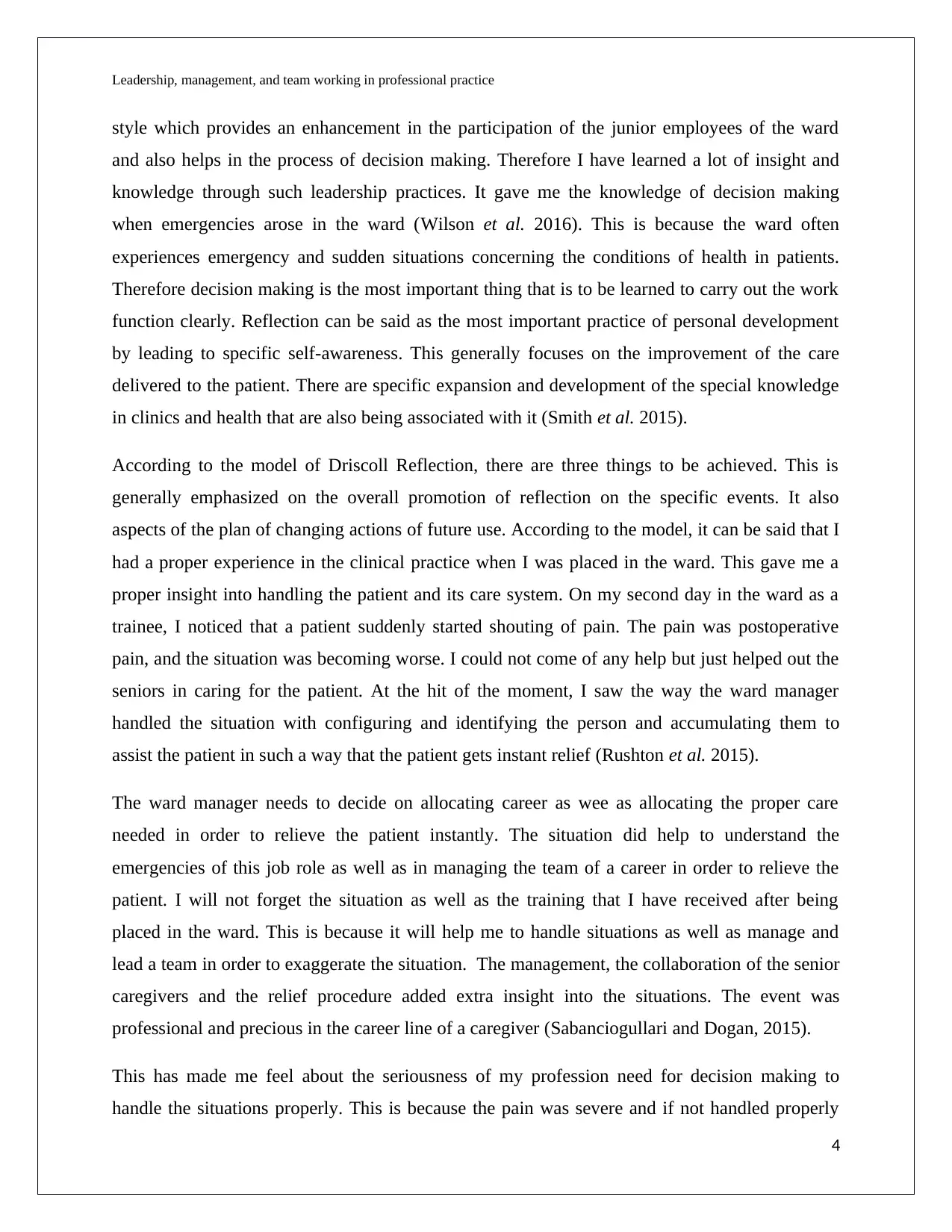
Leadership, management, and team working in professional practice
style which provides an enhancement in the participation of the junior employees of the ward
and also helps in the process of decision making. Therefore I have learned a lot of insight and
knowledge through such leadership practices. It gave me the knowledge of decision making
when emergencies arose in the ward (Wilson et al. 2016). This is because the ward often
experiences emergency and sudden situations concerning the conditions of health in patients.
Therefore decision making is the most important thing that is to be learned to carry out the work
function clearly. Reflection can be said as the most important practice of personal development
by leading to specific self-awareness. This generally focuses on the improvement of the care
delivered to the patient. There are specific expansion and development of the special knowledge
in clinics and health that are also being associated with it (Smith et al. 2015).
According to the model of Driscoll Reflection, there are three things to be achieved. This is
generally emphasized on the overall promotion of reflection on the specific events. It also
aspects of the plan of changing actions of future use. According to the model, it can be said that I
had a proper experience in the clinical practice when I was placed in the ward. This gave me a
proper insight into handling the patient and its care system. On my second day in the ward as a
trainee, I noticed that a patient suddenly started shouting of pain. The pain was postoperative
pain, and the situation was becoming worse. I could not come of any help but just helped out the
seniors in caring for the patient. At the hit of the moment, I saw the way the ward manager
handled the situation with configuring and identifying the person and accumulating them to
assist the patient in such a way that the patient gets instant relief (Rushton et al. 2015).
The ward manager needs to decide on allocating career as wee as allocating the proper care
needed in order to relieve the patient instantly. The situation did help to understand the
emergencies of this job role as well as in managing the team of a career in order to relieve the
patient. I will not forget the situation as well as the training that I have received after being
placed in the ward. This is because it will help me to handle situations as well as manage and
lead a team in order to exaggerate the situation. The management, the collaboration of the senior
caregivers and the relief procedure added extra insight into the situations. The event was
professional and precious in the career line of a caregiver (Sabanciogullari and Dogan, 2015).
This has made me feel about the seriousness of my profession need for decision making to
handle the situations properly. This is because the pain was severe and if not handled properly
4
style which provides an enhancement in the participation of the junior employees of the ward
and also helps in the process of decision making. Therefore I have learned a lot of insight and
knowledge through such leadership practices. It gave me the knowledge of decision making
when emergencies arose in the ward (Wilson et al. 2016). This is because the ward often
experiences emergency and sudden situations concerning the conditions of health in patients.
Therefore decision making is the most important thing that is to be learned to carry out the work
function clearly. Reflection can be said as the most important practice of personal development
by leading to specific self-awareness. This generally focuses on the improvement of the care
delivered to the patient. There are specific expansion and development of the special knowledge
in clinics and health that are also being associated with it (Smith et al. 2015).
According to the model of Driscoll Reflection, there are three things to be achieved. This is
generally emphasized on the overall promotion of reflection on the specific events. It also
aspects of the plan of changing actions of future use. According to the model, it can be said that I
had a proper experience in the clinical practice when I was placed in the ward. This gave me a
proper insight into handling the patient and its care system. On my second day in the ward as a
trainee, I noticed that a patient suddenly started shouting of pain. The pain was postoperative
pain, and the situation was becoming worse. I could not come of any help but just helped out the
seniors in caring for the patient. At the hit of the moment, I saw the way the ward manager
handled the situation with configuring and identifying the person and accumulating them to
assist the patient in such a way that the patient gets instant relief (Rushton et al. 2015).
The ward manager needs to decide on allocating career as wee as allocating the proper care
needed in order to relieve the patient instantly. The situation did help to understand the
emergencies of this job role as well as in managing the team of a career in order to relieve the
patient. I will not forget the situation as well as the training that I have received after being
placed in the ward. This is because it will help me to handle situations as well as manage and
lead a team in order to exaggerate the situation. The management, the collaboration of the senior
caregivers and the relief procedure added extra insight into the situations. The event was
professional and precious in the career line of a caregiver (Sabanciogullari and Dogan, 2015).
This has made me feel about the seriousness of my profession need for decision making to
handle the situations properly. This is because the pain was severe and if not handled properly
4
Secure Best Marks with AI Grader
Need help grading? Try our AI Grader for instant feedback on your assignments.
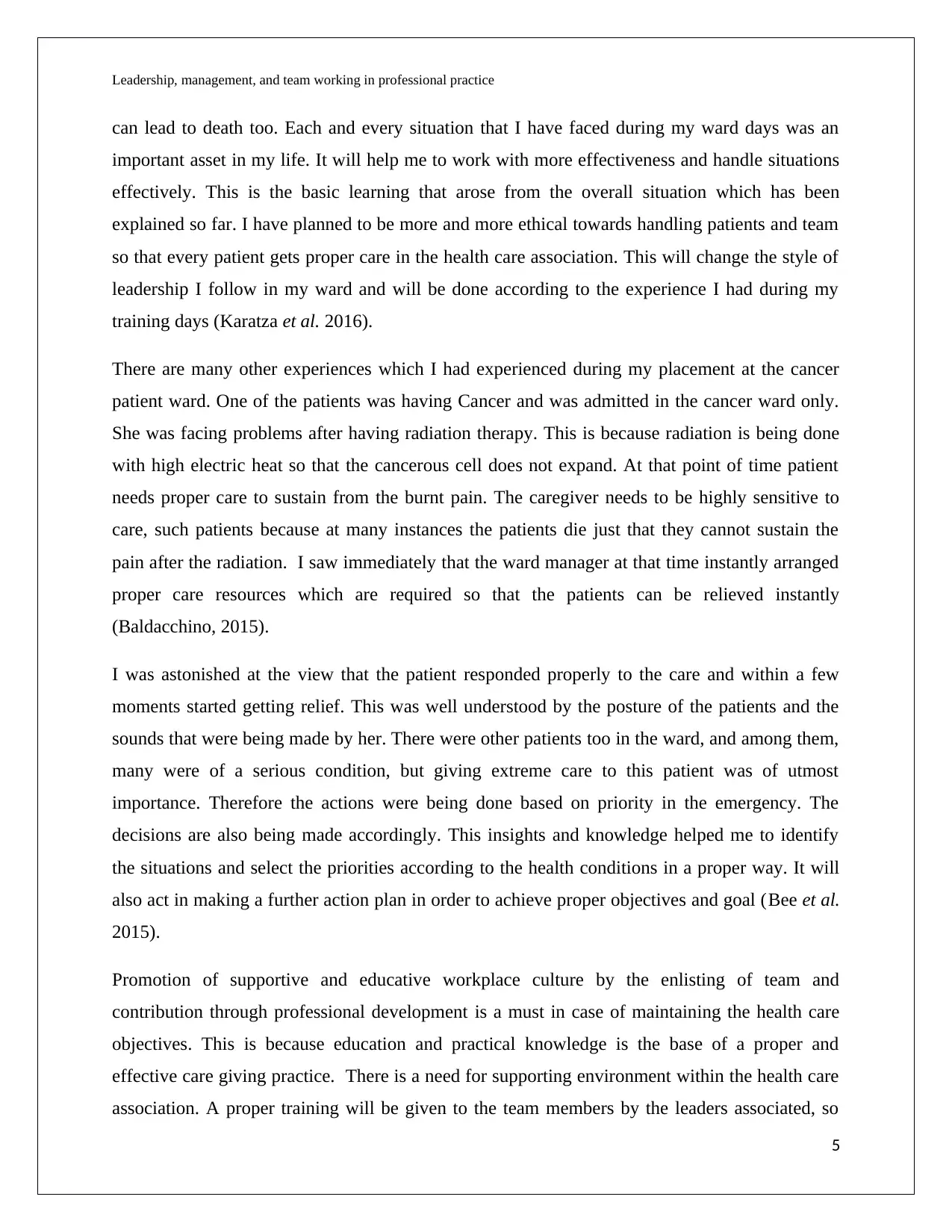
Leadership, management, and team working in professional practice
can lead to death too. Each and every situation that I have faced during my ward days was an
important asset in my life. It will help me to work with more effectiveness and handle situations
effectively. This is the basic learning that arose from the overall situation which has been
explained so far. I have planned to be more and more ethical towards handling patients and team
so that every patient gets proper care in the health care association. This will change the style of
leadership I follow in my ward and will be done according to the experience I had during my
training days (Karatza et al. 2016).
There are many other experiences which I had experienced during my placement at the cancer
patient ward. One of the patients was having Cancer and was admitted in the cancer ward only.
She was facing problems after having radiation therapy. This is because radiation is being done
with high electric heat so that the cancerous cell does not expand. At that point of time patient
needs proper care to sustain from the burnt pain. The caregiver needs to be highly sensitive to
care, such patients because at many instances the patients die just that they cannot sustain the
pain after the radiation. I saw immediately that the ward manager at that time instantly arranged
proper care resources which are required so that the patients can be relieved instantly
(Baldacchino, 2015).
I was astonished at the view that the patient responded properly to the care and within a few
moments started getting relief. This was well understood by the posture of the patients and the
sounds that were being made by her. There were other patients too in the ward, and among them,
many were of a serious condition, but giving extreme care to this patient was of utmost
importance. Therefore the actions were being done based on priority in the emergency. The
decisions are also being made accordingly. This insights and knowledge helped me to identify
the situations and select the priorities according to the health conditions in a proper way. It will
also act in making a further action plan in order to achieve proper objectives and goal (Bee et al.
2015).
Promotion of supportive and educative workplace culture by the enlisting of team and
contribution through professional development is a must in case of maintaining the health care
objectives. This is because education and practical knowledge is the base of a proper and
effective care giving practice. There is a need for supporting environment within the health care
association. A proper training will be given to the team members by the leaders associated, so
5
can lead to death too. Each and every situation that I have faced during my ward days was an
important asset in my life. It will help me to work with more effectiveness and handle situations
effectively. This is the basic learning that arose from the overall situation which has been
explained so far. I have planned to be more and more ethical towards handling patients and team
so that every patient gets proper care in the health care association. This will change the style of
leadership I follow in my ward and will be done according to the experience I had during my
training days (Karatza et al. 2016).
There are many other experiences which I had experienced during my placement at the cancer
patient ward. One of the patients was having Cancer and was admitted in the cancer ward only.
She was facing problems after having radiation therapy. This is because radiation is being done
with high electric heat so that the cancerous cell does not expand. At that point of time patient
needs proper care to sustain from the burnt pain. The caregiver needs to be highly sensitive to
care, such patients because at many instances the patients die just that they cannot sustain the
pain after the radiation. I saw immediately that the ward manager at that time instantly arranged
proper care resources which are required so that the patients can be relieved instantly
(Baldacchino, 2015).
I was astonished at the view that the patient responded properly to the care and within a few
moments started getting relief. This was well understood by the posture of the patients and the
sounds that were being made by her. There were other patients too in the ward, and among them,
many were of a serious condition, but giving extreme care to this patient was of utmost
importance. Therefore the actions were being done based on priority in the emergency. The
decisions are also being made accordingly. This insights and knowledge helped me to identify
the situations and select the priorities according to the health conditions in a proper way. It will
also act in making a further action plan in order to achieve proper objectives and goal (Bee et al.
2015).
Promotion of supportive and educative workplace culture by the enlisting of team and
contribution through professional development is a must in case of maintaining the health care
objectives. This is because education and practical knowledge is the base of a proper and
effective care giving practice. There is a need for supporting environment within the health care
association. A proper training will be given to the team members by the leaders associated, so
5
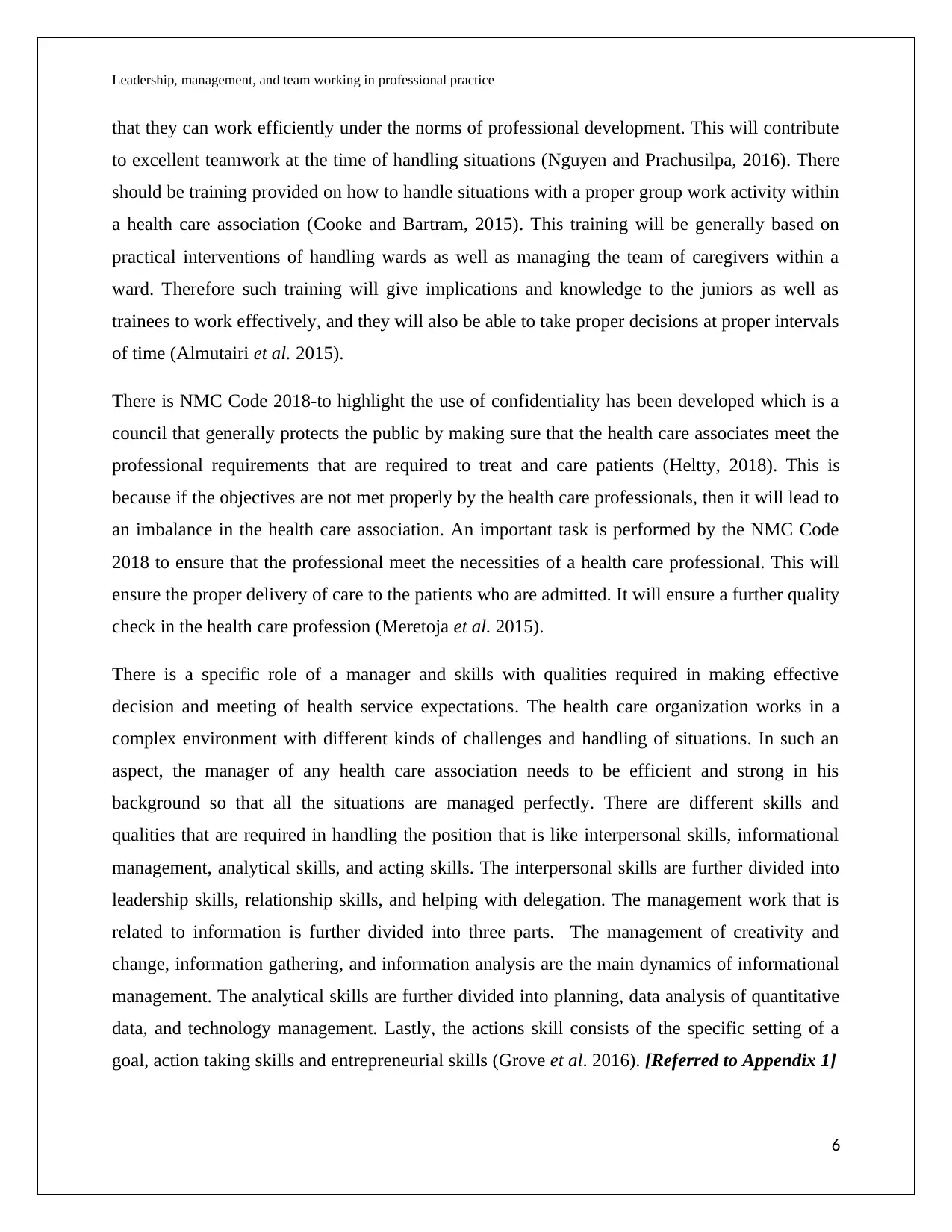
Leadership, management, and team working in professional practice
that they can work efficiently under the norms of professional development. This will contribute
to excellent teamwork at the time of handling situations (Nguyen and Prachusilpa, 2016). There
should be training provided on how to handle situations with a proper group work activity within
a health care association (Cooke and Bartram, 2015). This training will be generally based on
practical interventions of handling wards as well as managing the team of caregivers within a
ward. Therefore such training will give implications and knowledge to the juniors as well as
trainees to work effectively, and they will also be able to take proper decisions at proper intervals
of time (Almutairi et al. 2015).
There is NMC Code 2018-to highlight the use of confidentiality has been developed which is a
council that generally protects the public by making sure that the health care associates meet the
professional requirements that are required to treat and care patients (Heltty, 2018). This is
because if the objectives are not met properly by the health care professionals, then it will lead to
an imbalance in the health care association. An important task is performed by the NMC Code
2018 to ensure that the professional meet the necessities of a health care professional. This will
ensure the proper delivery of care to the patients who are admitted. It will ensure a further quality
check in the health care profession (Meretoja et al. 2015).
There is a specific role of a manager and skills with qualities required in making effective
decision and meeting of health service expectations. The health care organization works in a
complex environment with different kinds of challenges and handling of situations. In such an
aspect, the manager of any health care association needs to be efficient and strong in his
background so that all the situations are managed perfectly. There are different skills and
qualities that are required in handling the position that is like interpersonal skills, informational
management, analytical skills, and acting skills. The interpersonal skills are further divided into
leadership skills, relationship skills, and helping with delegation. The management work that is
related to information is further divided into three parts. The management of creativity and
change, information gathering, and information analysis are the main dynamics of informational
management. The analytical skills are further divided into planning, data analysis of quantitative
data, and technology management. Lastly, the actions skill consists of the specific setting of a
goal, action taking skills and entrepreneurial skills (Grove et al. 2016). [Referred to Appendix 1]
6
that they can work efficiently under the norms of professional development. This will contribute
to excellent teamwork at the time of handling situations (Nguyen and Prachusilpa, 2016). There
should be training provided on how to handle situations with a proper group work activity within
a health care association (Cooke and Bartram, 2015). This training will be generally based on
practical interventions of handling wards as well as managing the team of caregivers within a
ward. Therefore such training will give implications and knowledge to the juniors as well as
trainees to work effectively, and they will also be able to take proper decisions at proper intervals
of time (Almutairi et al. 2015).
There is NMC Code 2018-to highlight the use of confidentiality has been developed which is a
council that generally protects the public by making sure that the health care associates meet the
professional requirements that are required to treat and care patients (Heltty, 2018). This is
because if the objectives are not met properly by the health care professionals, then it will lead to
an imbalance in the health care association. An important task is performed by the NMC Code
2018 to ensure that the professional meet the necessities of a health care professional. This will
ensure the proper delivery of care to the patients who are admitted. It will ensure a further quality
check in the health care profession (Meretoja et al. 2015).
There is a specific role of a manager and skills with qualities required in making effective
decision and meeting of health service expectations. The health care organization works in a
complex environment with different kinds of challenges and handling of situations. In such an
aspect, the manager of any health care association needs to be efficient and strong in his
background so that all the situations are managed perfectly. There are different skills and
qualities that are required in handling the position that is like interpersonal skills, informational
management, analytical skills, and acting skills. The interpersonal skills are further divided into
leadership skills, relationship skills, and helping with delegation. The management work that is
related to information is further divided into three parts. The management of creativity and
change, information gathering, and information analysis are the main dynamics of informational
management. The analytical skills are further divided into planning, data analysis of quantitative
data, and technology management. Lastly, the actions skill consists of the specific setting of a
goal, action taking skills and entrepreneurial skills (Grove et al. 2016). [Referred to Appendix 1]
6
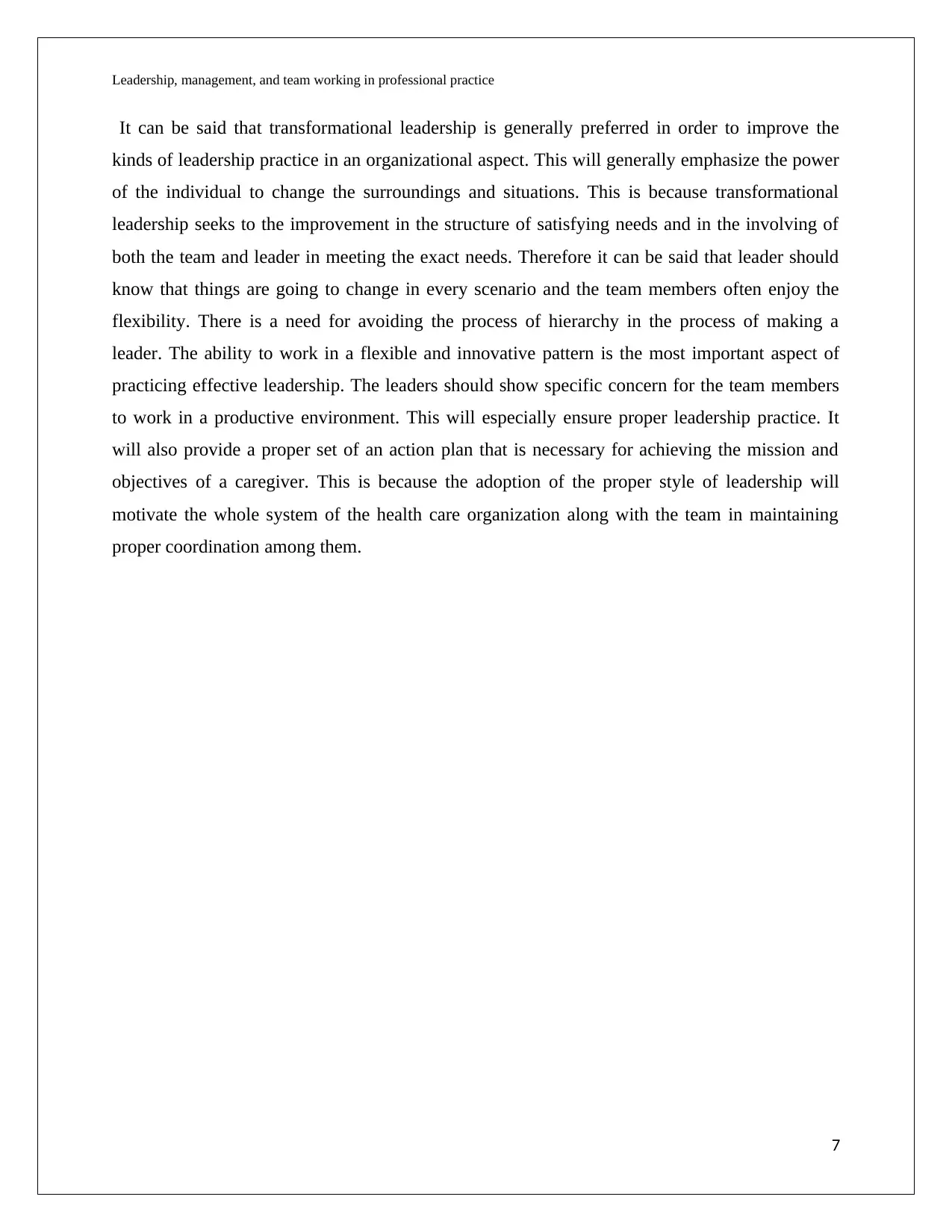
Leadership, management, and team working in professional practice
It can be said that transformational leadership is generally preferred in order to improve the
kinds of leadership practice in an organizational aspect. This will generally emphasize the power
of the individual to change the surroundings and situations. This is because transformational
leadership seeks to the improvement in the structure of satisfying needs and in the involving of
both the team and leader in meeting the exact needs. Therefore it can be said that leader should
know that things are going to change in every scenario and the team members often enjoy the
flexibility. There is a need for avoiding the process of hierarchy in the process of making a
leader. The ability to work in a flexible and innovative pattern is the most important aspect of
practicing effective leadership. The leaders should show specific concern for the team members
to work in a productive environment. This will especially ensure proper leadership practice. It
will also provide a proper set of an action plan that is necessary for achieving the mission and
objectives of a caregiver. This is because the adoption of the proper style of leadership will
motivate the whole system of the health care organization along with the team in maintaining
proper coordination among them.
7
It can be said that transformational leadership is generally preferred in order to improve the
kinds of leadership practice in an organizational aspect. This will generally emphasize the power
of the individual to change the surroundings and situations. This is because transformational
leadership seeks to the improvement in the structure of satisfying needs and in the involving of
both the team and leader in meeting the exact needs. Therefore it can be said that leader should
know that things are going to change in every scenario and the team members often enjoy the
flexibility. There is a need for avoiding the process of hierarchy in the process of making a
leader. The ability to work in a flexible and innovative pattern is the most important aspect of
practicing effective leadership. The leaders should show specific concern for the team members
to work in a productive environment. This will especially ensure proper leadership practice. It
will also provide a proper set of an action plan that is necessary for achieving the mission and
objectives of a caregiver. This is because the adoption of the proper style of leadership will
motivate the whole system of the health care organization along with the team in maintaining
proper coordination among them.
7
Paraphrase This Document
Need a fresh take? Get an instant paraphrase of this document with our AI Paraphraser
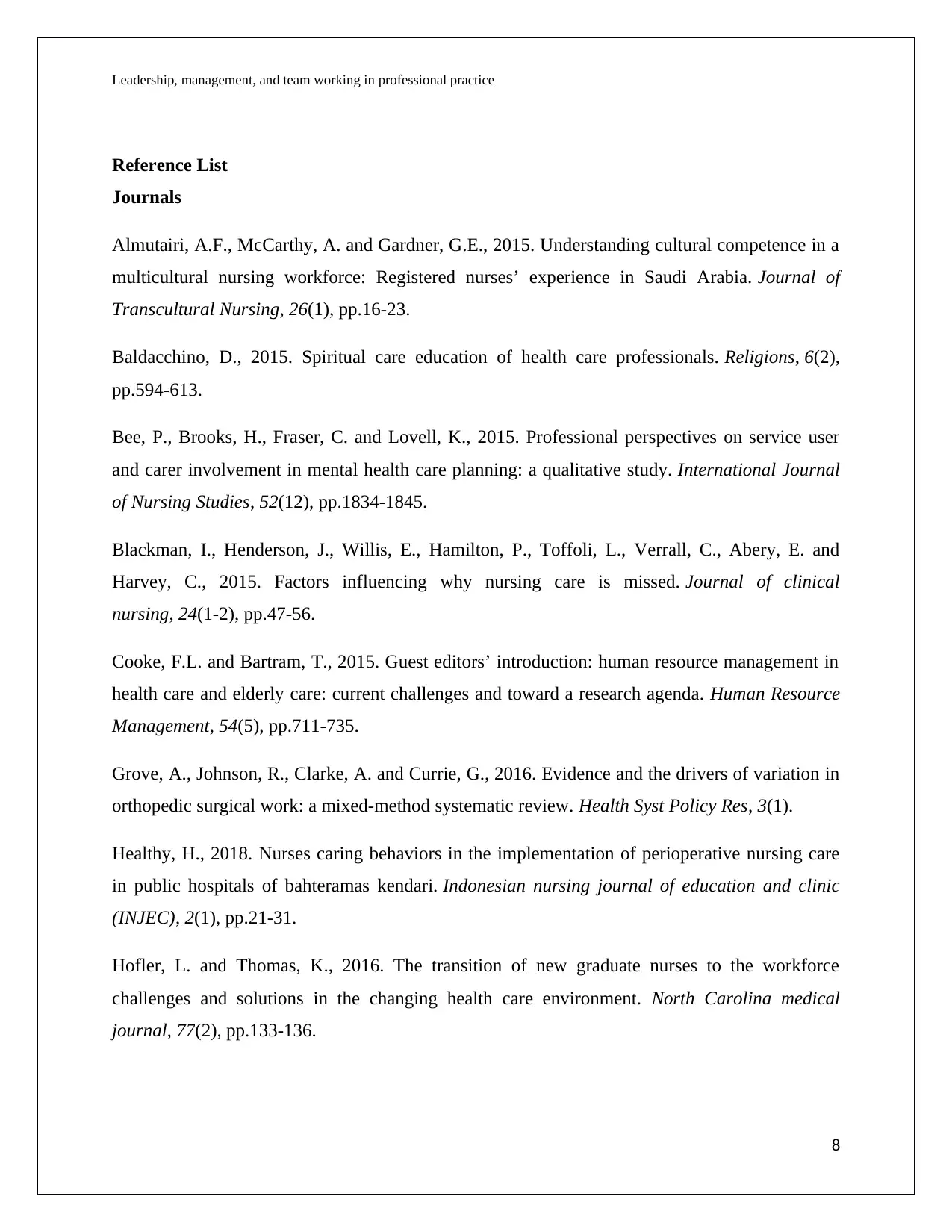
Leadership, management, and team working in professional practice
Reference List
Journals
Almutairi, A.F., McCarthy, A. and Gardner, G.E., 2015. Understanding cultural competence in a
multicultural nursing workforce: Registered nurses’ experience in Saudi Arabia. Journal of
Transcultural Nursing, 26(1), pp.16-23.
Baldacchino, D., 2015. Spiritual care education of health care professionals. Religions, 6(2),
pp.594-613.
Bee, P., Brooks, H., Fraser, C. and Lovell, K., 2015. Professional perspectives on service user
and carer involvement in mental health care planning: a qualitative study. International Journal
of Nursing Studies, 52(12), pp.1834-1845.
Blackman, I., Henderson, J., Willis, E., Hamilton, P., Toffoli, L., Verrall, C., Abery, E. and
Harvey, C., 2015. Factors influencing why nursing care is missed. Journal of clinical
nursing, 24(1-2), pp.47-56.
Cooke, F.L. and Bartram, T., 2015. Guest editors’ introduction: human resource management in
health care and elderly care: current challenges and toward a research agenda. Human Resource
Management, 54(5), pp.711-735.
Grove, A., Johnson, R., Clarke, A. and Currie, G., 2016. Evidence and the drivers of variation in
orthopedic surgical work: a mixed-method systematic review. Health Syst Policy Res, 3(1).
Healthy, H., 2018. Nurses caring behaviors in the implementation of perioperative nursing care
in public hospitals of bahteramas kendari. Indonesian nursing journal of education and clinic
(INJEC), 2(1), pp.21-31.
Hofler, L. and Thomas, K., 2016. The transition of new graduate nurses to the workforce
challenges and solutions in the changing health care environment. North Carolina medical
journal, 77(2), pp.133-136.
8
Reference List
Journals
Almutairi, A.F., McCarthy, A. and Gardner, G.E., 2015. Understanding cultural competence in a
multicultural nursing workforce: Registered nurses’ experience in Saudi Arabia. Journal of
Transcultural Nursing, 26(1), pp.16-23.
Baldacchino, D., 2015. Spiritual care education of health care professionals. Religions, 6(2),
pp.594-613.
Bee, P., Brooks, H., Fraser, C. and Lovell, K., 2015. Professional perspectives on service user
and carer involvement in mental health care planning: a qualitative study. International Journal
of Nursing Studies, 52(12), pp.1834-1845.
Blackman, I., Henderson, J., Willis, E., Hamilton, P., Toffoli, L., Verrall, C., Abery, E. and
Harvey, C., 2015. Factors influencing why nursing care is missed. Journal of clinical
nursing, 24(1-2), pp.47-56.
Cooke, F.L. and Bartram, T., 2015. Guest editors’ introduction: human resource management in
health care and elderly care: current challenges and toward a research agenda. Human Resource
Management, 54(5), pp.711-735.
Grove, A., Johnson, R., Clarke, A. and Currie, G., 2016. Evidence and the drivers of variation in
orthopedic surgical work: a mixed-method systematic review. Health Syst Policy Res, 3(1).
Healthy, H., 2018. Nurses caring behaviors in the implementation of perioperative nursing care
in public hospitals of bahteramas kendari. Indonesian nursing journal of education and clinic
(INJEC), 2(1), pp.21-31.
Hofler, L. and Thomas, K., 2016. The transition of new graduate nurses to the workforce
challenges and solutions in the changing health care environment. North Carolina medical
journal, 77(2), pp.133-136.
8
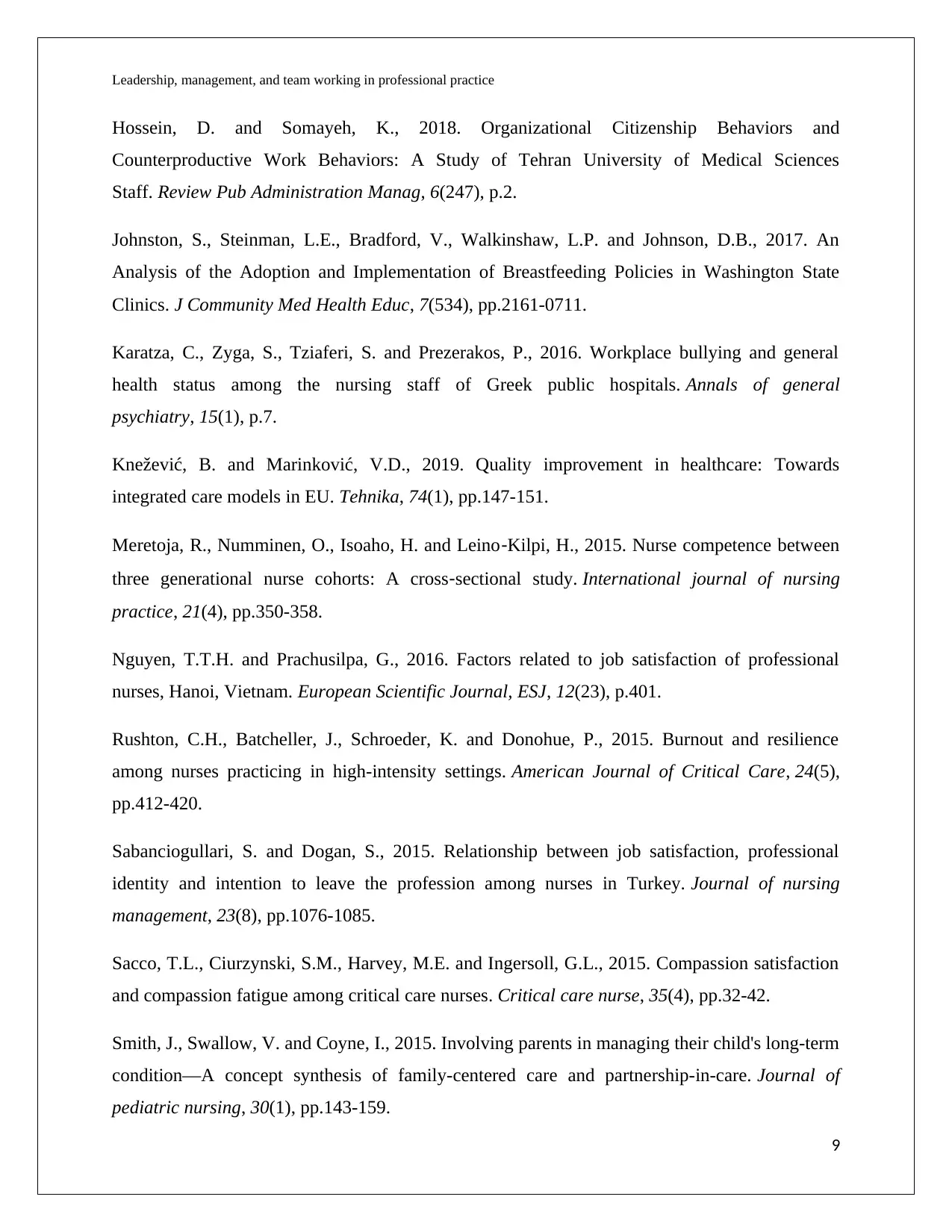
Leadership, management, and team working in professional practice
Hossein, D. and Somayeh, K., 2018. Organizational Citizenship Behaviors and
Counterproductive Work Behaviors: A Study of Tehran University of Medical Sciences
Staff. Review Pub Administration Manag, 6(247), p.2.
Johnston, S., Steinman, L.E., Bradford, V., Walkinshaw, L.P. and Johnson, D.B., 2017. An
Analysis of the Adoption and Implementation of Breastfeeding Policies in Washington State
Clinics. J Community Med Health Educ, 7(534), pp.2161-0711.
Karatza, C., Zyga, S., Tziaferi, S. and Prezerakos, P., 2016. Workplace bullying and general
health status among the nursing staff of Greek public hospitals. Annals of general
psychiatry, 15(1), p.7.
Knežević, B. and Marinković, V.D., 2019. Quality improvement in healthcare: Towards
integrated care models in EU. Tehnika, 74(1), pp.147-151.
Meretoja, R., Numminen, O., Isoaho, H. and Leino‐Kilpi, H., 2015. Nurse competence between
three generational nurse cohorts: A cross‐sectional study. International journal of nursing
practice, 21(4), pp.350-358.
Nguyen, T.T.H. and Prachusilpa, G., 2016. Factors related to job satisfaction of professional
nurses, Hanoi, Vietnam. European Scientific Journal, ESJ, 12(23), p.401.
Rushton, C.H., Batcheller, J., Schroeder, K. and Donohue, P., 2015. Burnout and resilience
among nurses practicing in high-intensity settings. American Journal of Critical Care, 24(5),
pp.412-420.
Sabanciogullari, S. and Dogan, S., 2015. Relationship between job satisfaction, professional
identity and intention to leave the profession among nurses in Turkey. Journal of nursing
management, 23(8), pp.1076-1085.
Sacco, T.L., Ciurzynski, S.M., Harvey, M.E. and Ingersoll, G.L., 2015. Compassion satisfaction
and compassion fatigue among critical care nurses. Critical care nurse, 35(4), pp.32-42.
Smith, J., Swallow, V. and Coyne, I., 2015. Involving parents in managing their child's long-term
condition—A concept synthesis of family-centered care and partnership-in-care. Journal of
pediatric nursing, 30(1), pp.143-159.
9
Hossein, D. and Somayeh, K., 2018. Organizational Citizenship Behaviors and
Counterproductive Work Behaviors: A Study of Tehran University of Medical Sciences
Staff. Review Pub Administration Manag, 6(247), p.2.
Johnston, S., Steinman, L.E., Bradford, V., Walkinshaw, L.P. and Johnson, D.B., 2017. An
Analysis of the Adoption and Implementation of Breastfeeding Policies in Washington State
Clinics. J Community Med Health Educ, 7(534), pp.2161-0711.
Karatza, C., Zyga, S., Tziaferi, S. and Prezerakos, P., 2016. Workplace bullying and general
health status among the nursing staff of Greek public hospitals. Annals of general
psychiatry, 15(1), p.7.
Knežević, B. and Marinković, V.D., 2019. Quality improvement in healthcare: Towards
integrated care models in EU. Tehnika, 74(1), pp.147-151.
Meretoja, R., Numminen, O., Isoaho, H. and Leino‐Kilpi, H., 2015. Nurse competence between
three generational nurse cohorts: A cross‐sectional study. International journal of nursing
practice, 21(4), pp.350-358.
Nguyen, T.T.H. and Prachusilpa, G., 2016. Factors related to job satisfaction of professional
nurses, Hanoi, Vietnam. European Scientific Journal, ESJ, 12(23), p.401.
Rushton, C.H., Batcheller, J., Schroeder, K. and Donohue, P., 2015. Burnout and resilience
among nurses practicing in high-intensity settings. American Journal of Critical Care, 24(5),
pp.412-420.
Sabanciogullari, S. and Dogan, S., 2015. Relationship between job satisfaction, professional
identity and intention to leave the profession among nurses in Turkey. Journal of nursing
management, 23(8), pp.1076-1085.
Sacco, T.L., Ciurzynski, S.M., Harvey, M.E. and Ingersoll, G.L., 2015. Compassion satisfaction
and compassion fatigue among critical care nurses. Critical care nurse, 35(4), pp.32-42.
Smith, J., Swallow, V. and Coyne, I., 2015. Involving parents in managing their child's long-term
condition—A concept synthesis of family-centered care and partnership-in-care. Journal of
pediatric nursing, 30(1), pp.143-159.
9
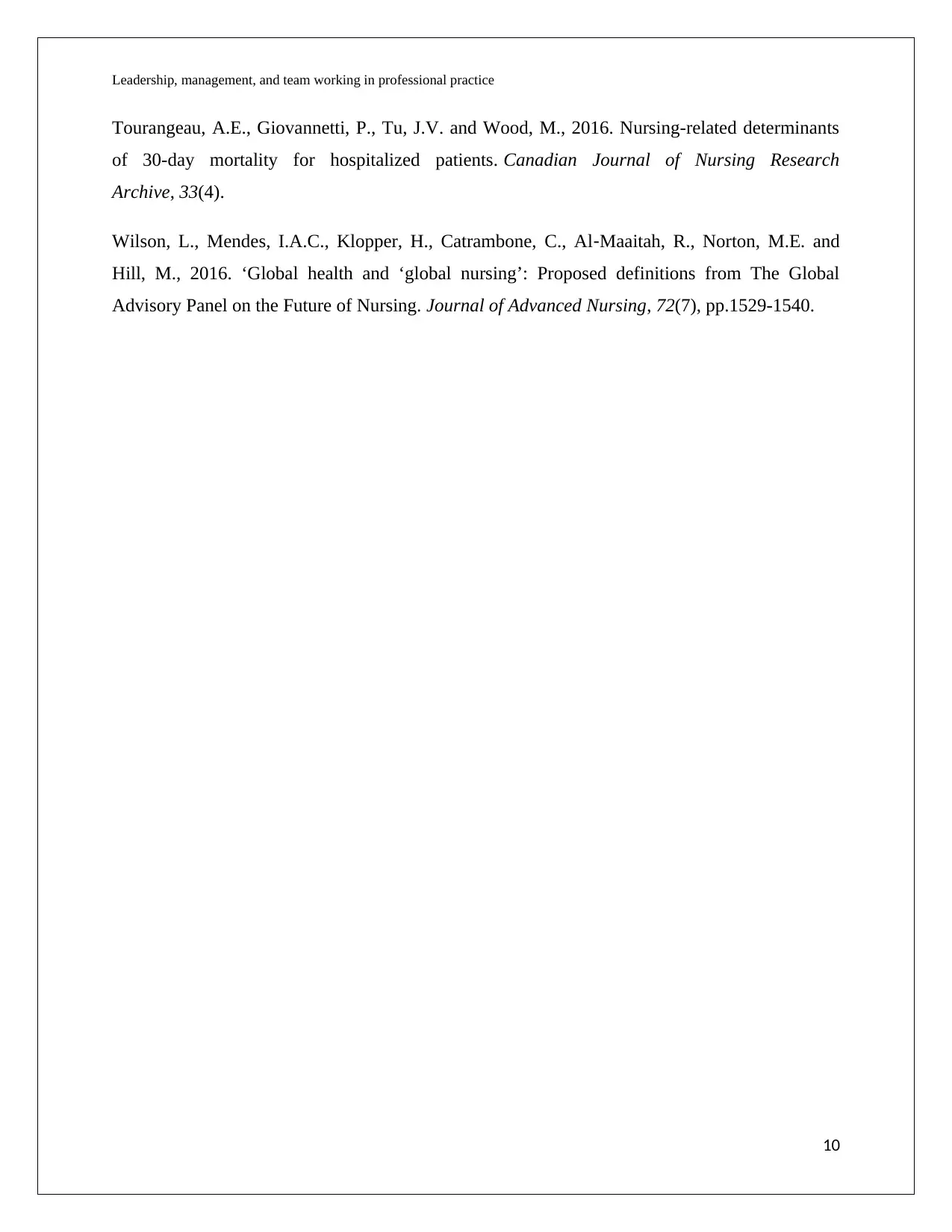
Leadership, management, and team working in professional practice
Tourangeau, A.E., Giovannetti, P., Tu, J.V. and Wood, M., 2016. Nursing-related determinants
of 30-day mortality for hospitalized patients. Canadian Journal of Nursing Research
Archive, 33(4).
Wilson, L., Mendes, I.A.C., Klopper, H., Catrambone, C., Al‐Maaitah, R., Norton, M.E. and
Hill, M., 2016. ‘Global health and ‘global nursing’: Proposed definitions from The Global
Advisory Panel on the Future of Nursing. Journal of Advanced Nursing, 72(7), pp.1529-1540.
10
Tourangeau, A.E., Giovannetti, P., Tu, J.V. and Wood, M., 2016. Nursing-related determinants
of 30-day mortality for hospitalized patients. Canadian Journal of Nursing Research
Archive, 33(4).
Wilson, L., Mendes, I.A.C., Klopper, H., Catrambone, C., Al‐Maaitah, R., Norton, M.E. and
Hill, M., 2016. ‘Global health and ‘global nursing’: Proposed definitions from The Global
Advisory Panel on the Future of Nursing. Journal of Advanced Nursing, 72(7), pp.1529-1540.
10
Secure Best Marks with AI Grader
Need help grading? Try our AI Grader for instant feedback on your assignments.
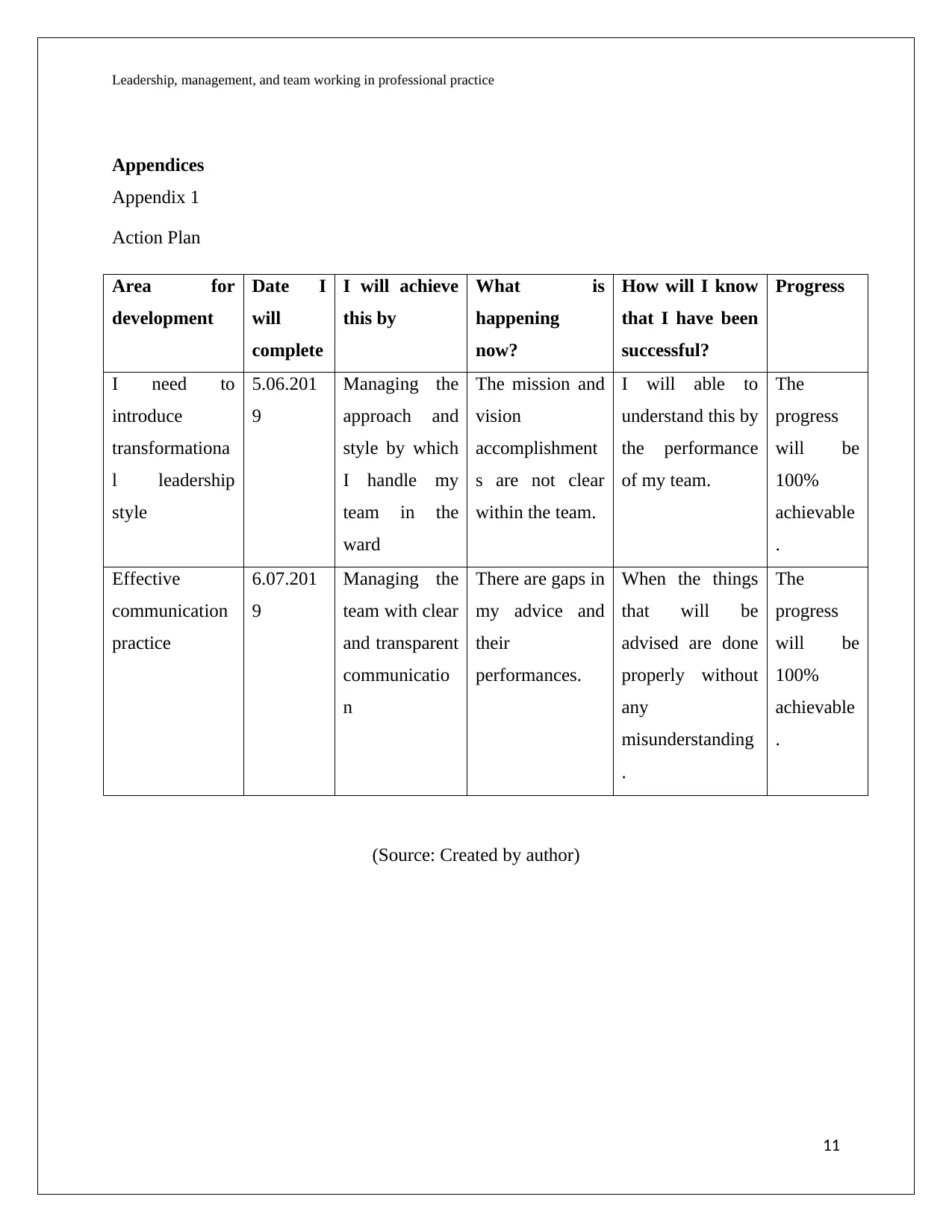
Leadership, management, and team working in professional practice
Appendices
Appendix 1
Action Plan
Area for
development
Date I
will
complete
I will achieve
this by
What is
happening
now?
How will I know
that I have been
successful?
Progress
I need to
introduce
transformationa
l leadership
style
5.06.201
9
Managing the
approach and
style by which
I handle my
team in the
ward
The mission and
vision
accomplishment
s are not clear
within the team.
I will able to
understand this by
the performance
of my team.
The
progress
will be
100%
achievable
.
Effective
communication
practice
6.07.201
9
Managing the
team with clear
and transparent
communicatio
n
There are gaps in
my advice and
their
performances.
When the things
that will be
advised are done
properly without
any
misunderstanding
.
The
progress
will be
100%
achievable
.
(Source: Created by author)
11
Appendices
Appendix 1
Action Plan
Area for
development
Date I
will
complete
I will achieve
this by
What is
happening
now?
How will I know
that I have been
successful?
Progress
I need to
introduce
transformationa
l leadership
style
5.06.201
9
Managing the
approach and
style by which
I handle my
team in the
ward
The mission and
vision
accomplishment
s are not clear
within the team.
I will able to
understand this by
the performance
of my team.
The
progress
will be
100%
achievable
.
Effective
communication
practice
6.07.201
9
Managing the
team with clear
and transparent
communicatio
n
There are gaps in
my advice and
their
performances.
When the things
that will be
advised are done
properly without
any
misunderstanding
.
The
progress
will be
100%
achievable
.
(Source: Created by author)
11
1 out of 11
Related Documents
Your All-in-One AI-Powered Toolkit for Academic Success.
+13062052269
info@desklib.com
Available 24*7 on WhatsApp / Email
![[object Object]](/_next/static/media/star-bottom.7253800d.svg)
Unlock your academic potential
© 2024 | Zucol Services PVT LTD | All rights reserved.




